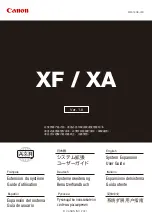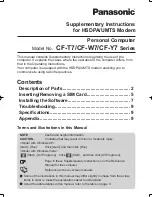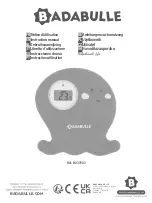
7
E
Contents
• Stud Sensor Information
• User Safety
• Battery Safety
• Installing AAA Batteries
• Using the Stud Sensor
• Maintenance
• Troubleshooting
• Service and Repairs
• Warranty
• Specifications
Stud Sensor Information
The Stud Sensor CMHT77623 uses electronic signals to locate the center
of wood or metal studs, live AC wires, or metal objects (e.g., pipe) through
drywall or other common building materials.
PLEASE NOTE:
• The stud sensor will not detect objects in concrete, mortar, block, brick work,
plaster, carpeting, foil-faced materials, metallic surfaces, or ceramic tile.
• The stud sensor will not detect plastic or PVC pipes.
Once the center of a wood or metal stud, or a metal object has been detected
in one pass across the surface, the Stud Sensor CMHT77623 turns on the
center LEDs and sounds an audible tone. A marking hole allows you to easily
note the current position on the wall.
User Safety
Safety Guidelines
The definitions below describe the level of severity for each signal word. Please
read the manual and pay attention to these symbols.
WARNING:
Indicates a potentially hazardous situation which, if not
avoided, could result in serious injury.
CAUTION:
Indicates a potentially hazardous situation which, if not
avoided, may result in minor or moderate injury.
NOTICE:
Indicates a practice not related to personal injury which, if not
avoided, may result in property damage.
If you have any questions or comments about this or any
CRAFTSMAN
®
tool,
go to www.CRAFTSMAN.com.
WARNING:
Read and understand all instructions
.
Failure to follow the
warnings and instructions in this manual may result in serious
personal injury.
SAVE THESE INSTRUCTIONS
WARNING:
The following label information can be found on your tool for your
safety.
WARNING:
If the equipment is used in a manner not specified by the
manufacturer, the protection provided by the equipment may be
impaired.
CAUTION:
Protect your eyes. Wear safety goggles.
WARNING:
This tool is not a measuring device and should not be used as a
substitute for a voltmeter.
WARNING:
The LED or Live Wire Detection symbol on the display is just an
indicator and in some situations the voltage detection option may
not accurately indicate the presence of voltage in a wall in the
event of internal device failure or improper operation, and therefore
should not be solely relied upon for identification of the presence of
hazardous voltages. Other evidence, such as construction blueprints
or visual identification of wiring or conduit entry points should also
be utilized.
Always follow proper safety practices and use a separate detection
method to verify a de-energized condition prior to commencing work.
WARNING:
Always turn off AC power when working near wiring.
WARNING:
Shielded wires or wires in metal conduits, casings, metalized walls,
or thick, dense walls may not be detected.
CAUTION:
Use personal protective equipment. Always wear eye protection.
Depending on the work conditions, wearing protective equipment
such as a dust mask, non-skid safety shoes, hard hat, and hearing
protection will reduce the risk of personal injury.
IMPORTANT SAFETY NOTICE
Ensure proper detection of live wires. Always hold the Stud Sensor CMHT77623
in the handle area only. Grasp between fingers and thumb while making
contact with your palm (Figure
C
1
).
Supplier’s Declaration of Conformity
47 CFR § 2.1077 Compliance Information
Unique Identifier:
CMHT77623
Responsible Party – U.S. Contact Information
CRAFTSMAN
701 East Joppa Road
Towson, Maryland 21286
www.CRAFTSMAN.com
FCC Statement
This equipment has been tested and found to comply with the limits for a
Class B digital device, pursuant to part 15 of the FCC Rules. These limits are
designed to provide reasonable protection against harmful interference in
a residential installation. This equipment generates, uses and can radiate
radio frequency energy and, if not installed and used in accordance with
the instructions, may cause harmful interference to radio communications.
However, there is no guarantee that interference will not occur in a particular
installation. If this equipment does cause harmful interference to radio or
television reception, which can be determined by turning the equipment off
and on, the user is encouraged to try to correct the interference by one or more
of the following measures:
- Reorient or relocate the receiving antenna.
- Increase the separation between the equipment and receiver.
Содержание CMHT77623
Страница 2: ...A 1 3 2 4 5 6 Figures 2 ...
Страница 3: ...C B 1 2 3 ...
Страница 4: ...D Figures 4 ...
Страница 5: ...E 1 2 5 2 18 12 AC 2020 09 XX AC 2020 09 XX ...
Страница 6: ...F Figures 6 ...
Страница 21: ...Notes ...








































